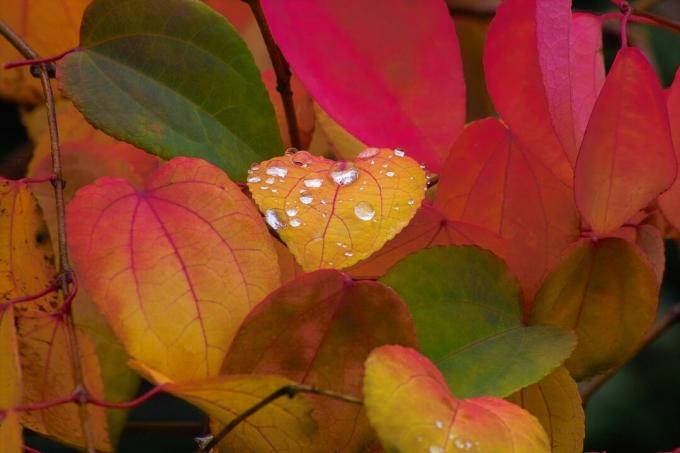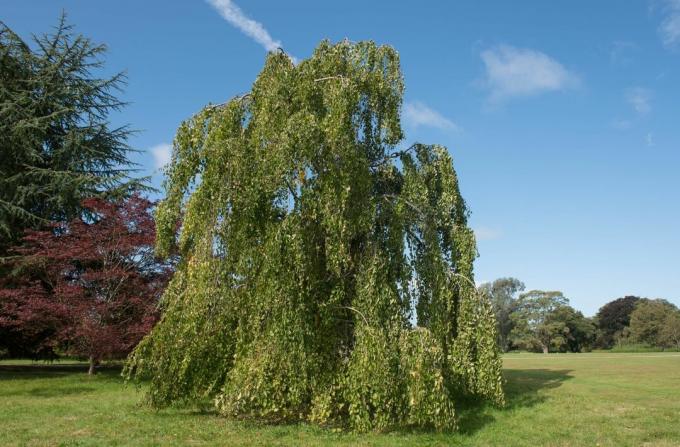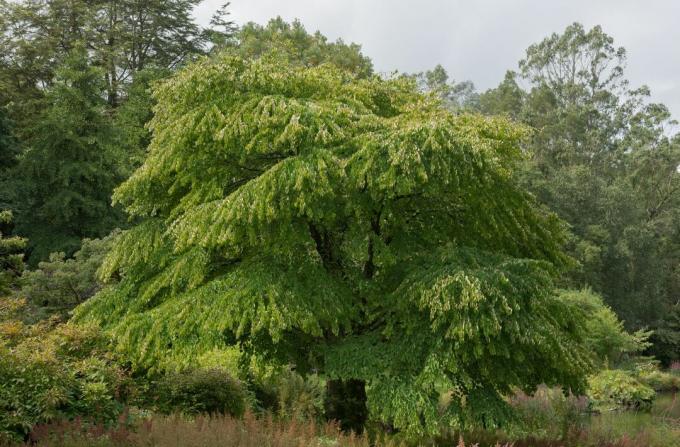The gingerbread tree is also called Japanese cake tree or Katsura tree. We present the tree, which is colorfully colored and particularly fragrant in autumn.

The gingerbread tree attracts attention with its twisted growth, the colorful foliage and its unique smell of caramel and cinnamon. In Europe it is still considered a rarity, which may be due to the special location preferences. Here you can find out which gingerbread tree varieties there are and how best to care for them.
"Contents"
- Gingerbread tree: flowering, origin and properties
- The most beautiful varieties of the cake tree
- Plant a gingerbread tree
-
The most important care measures
- Fertilize and water the cake tree
- Cut gingerbread tree
- Is the gingerbread tree poisonous?
Gingerbread tree: flowering, origin and properties
The Gingerbread Tree (Cercidiphyllum japonicum) comes from the pie tree family (Cercidiphyllaceae). It is also known as the Katsura tree, Judas leaf tree or just the cake tree.
The cake tree originally comes from East Asia, where it occurs particularly in China and Japan in humus-rich and moist locations such as river areas and mountain streams. Although it can also thrive in European weather conditions, it is still considered a rarity in this country. Occasionally, however, the gingerbread tree with its picturesque growth can be found both as an ornamental and as a scented plant in parks and gardens.
While the gingerbread tree grows to a height of around 30 meters in its natural range, it only reaches a maximum height of 10 meters in temperate latitudes. It is not uncommon for it to grow with multiple stems, which is why it is used here as a small tree or as a small tree. large shrub cultivated. Shortly after flowering, the brown-red and heart-shaped leaves sprout in April. These are similar to those of the lime tree and turn green in the following weeks, only the leaf stalks retain their red color. In September the autumn colors set in, the leaves first turning yellow-orange and then red, which is a magnificent spectacle. After and during the shedding of leaves in winter, the cake tree exudes a smell of caramel and cinnamon, which gives it its name. This is particularly pronounced in wet weather.

The cake tree is one of the four-season trees, as it pleases the eye with its colorful splendor almost all year round. The Japanese cake tree develops its clusters of flowers as early as April to May. The gingerbread tree is dioecious (dioecious), so male and female flowers are on different trees - there are therefore purely male and purely female plants. The female flower appears in a bright crimson and consists of long, strong branches with stigmas. The male flower is light red and consists of a dense tuft of anthers. If a female and a male tree stand together and are both sexually mature, the female specimens form small green follicles in autumn, which contain the small seeds.
The most beautiful varieties of the cake tree
- 'Pendulum': The hanging gingerbread tree 'Pendulum' is one of the prettiest varieties of the cake tree. The beautifully expansive growth with the hanging branches invites you to dream. The tree should be planted in isolation, not least to show it off better. With a height of 4 to 8 meters, it can stand outdoors or in a bucket. Since it grows very slowly, the hanging gingerbread tree in the pot can also be placed in an unheated conservatory. The 'Pendulum' variety is most commonly found in home nurseries, other varieties are rarely offered.

- 'red fox': Another variety of the gingerbread tree that has enjoyed enduring popularity is the 'Rotfuchs' variety. The 'red fox' is both 6 meters high and wide. Its leaves are striking red and are set in an umbrella-like crown. As a heat-loving tree, it is sensitive to late frosts.
- 'Strawberry': The sort Cercidiphyllum japonicum 'Strawberry' already has red-pink leaves with soft yellow tones in summer. Unfortunately, this variety is difficult to obtain commercially.

Plant a gingerbread tree
In spring or autumn, the gingerbread tree can be planted alone either directly outdoors or in a bucket. Choosing the right location plays an important role here. Due to its origin from river areas and waterfronts, the gingerbread tree needs a moist location. Especially the upper soil layers should always have enough moisture, since the gingerbread tree is a shallow root. Soil properties also play an important role. The cake tree prefers a loamy-clayey and nutrient-rich soil and tolerates both acidic and alkaline soil pH values.
Once the site has been selected, a sufficiently large hole is dug that is at least 1.5 times as wide and deep as the root ball. A nutrient-rich substrate can also be mixed into this so that the young tree can root better. A substrate with compost and clay is suitable, as this results in a high water and nutrient storage capacity in the root area of the tree. Ours, for example, is suitable for transplanting the gingerbread tree Plantura organic universal soil, which also does not require any peat at all.
Large trees, especially balled ones, will need one for the first 2 to 3 years after planting stable tree connection, so that the trunk is not pushed at an angle by the wind or the Katsura tree falls over. If possible, a tree connection should consist of two poles and be aligned at right angles to the main wind direction. It not only protects the tree from falling over, but also from excessive movement - which has the advantage that newly formed adventitious roots are protected and the plant grows faster.
Once the gingerbread tree has been inserted and the planting hole filled with soil and pressed, a casting ring can also be placed around the tree. For this purpose, a generous wall around the tree grate is modeled from earth. This creates a basin that you simply have to fill with water to pour.
tip: Optimally, the tree pit is finally covered with a thick layer of mulch to protect the soil from drying out quickly. Especially in the summer of the first year of growth, the Japanese cake tree definitely wants to come along regularly Water must be supplied because it does not yet have enough roots to do this itself deal with.

The most important care measures
If the ornamental small tree is in the right location, caring for the gingerbread tree is quite uncomplicated. The hardy tree is robust and well suited to the European climate. In addition, he is less susceptible to diseases. Nevertheless, attention should be paid to fertilization and irrigation to support the growth of the gingerbread tree and the beautiful autumn colors.
Fertilize and water the cake tree
The growth of the gingerbread tree can be promoted with the addition of fertilizer, which makes sense especially in nutrient-poor or sandy locations.
A predominantly organic fertilizer is particularly well suited to maintaining the soil qualities – water holding capacity and nutrient richness – that the Katsura tree needs. For example, our is suitable Plantura organic universal fertilizer, which should be applied to the gingerbread tree once a year in spring. The plant nutrients of the organic fertilizer are released over a long period of time and the organic matter promotes soil life.
A good alternative is the use of compost: This can also be spread on the tree pit in spring.
If a particularly strong autumn color is desired, the soil can be acidified. Because the following applies: the more acidic the soil, the stronger the beautiful autumn colors will be. You can read all about soil acidification in our article on soil pH Experienced.
In addition to fertilization, watering also plays a central role in the care of the gingerbread tree. In order to prevent premature leaf shedding, it must be watered sufficiently. However, if there is a dry period, the tree will sprout again after adding more water. It is therefore important to water the cake tree regularly, especially in the first few years.

Cut gingerbread tree
The picturesque growth of the gingerbread tree usually makes it unnecessary to cut the tree. If a cut is necessary, the best time to cut is between February and March, but definitely before mid-June. Dead branches should be removed with the saw at their base. Thinning pruning removes branches that point inward or cross each other.
tip: The gingerbread tree can be propagated using sticks. For this, young shoots are cut off the tree in May or June and pre-cultivated in a pot. For this purpose, a high-quality pricking soil like ours is used Plantura Bio–seed soil mixed with sand and optionally some rooting powder, inserted the stick and pressed down well. With enough water, the shoots will root and sprout. If a strong root system has developed after some time, the gingerbread tree can be planted outdoors.
Is the gingerbread tree poisonous?
The gingerbread tree and all its parts are not classified as poisonous. Even if there are no known signs of poisoning for humans or animals, the consumption of parts of the plant should be avoided.

With the right choice of location and care, the gingerbread tree is a wonderful eye-catcher. The smell of caramel and cinnamon in autumn does not go unnoticed either. By the way: did you know? The dried flowers of the clove also exude a delicious aroma. Everything you need to know about the Clove Cultivation we have put together in a profile.



